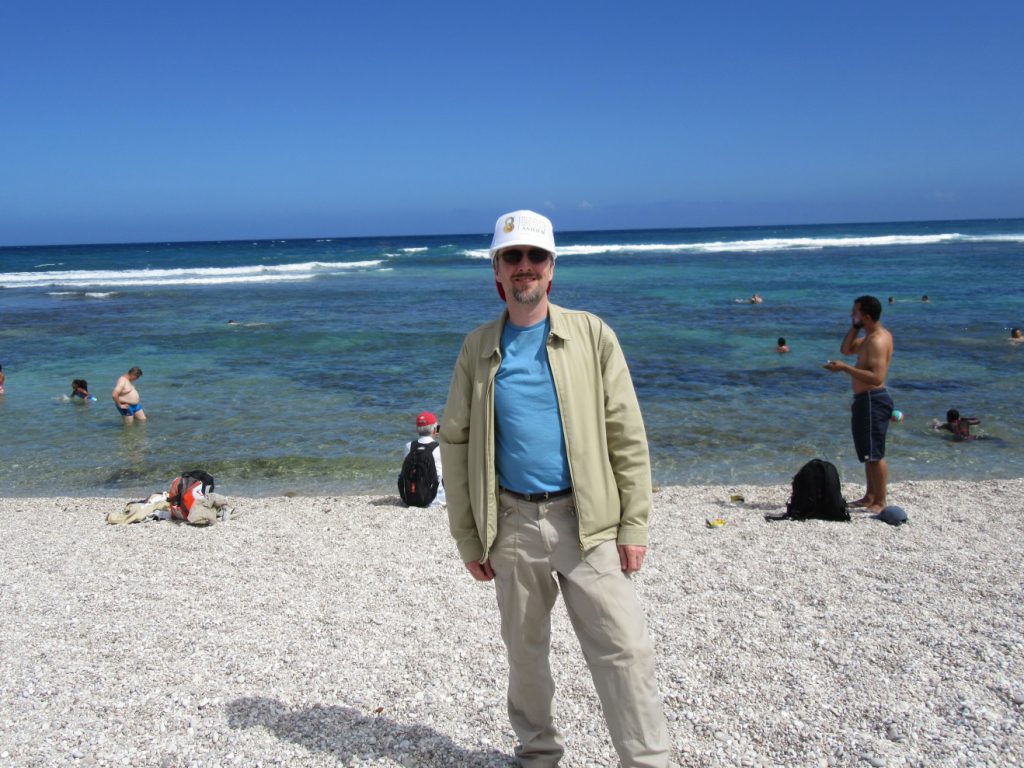This April, I travelled to Santo Domingo in the Dominican Republic to attend the 8th International Conference on Fossil Insects, Arthropods and Amber, along with my colleague Dr Vladmir Blagoderov, Principal Curator of Invertebrates, and around 80 other delegates.
This previous conference had been held at the National Museum of Scotland in 2016. This time, the conference was organised by the Director of the Amber World Museum, Jorge Caridad, and his daughter Jorelis and included 63 talks over three days on a variety of topics, though insects in amber dominated the proceedings.
Most of the third day was about insects and other arthropods in Burmese amber, which has received a phenomenal amount of attention over the last few years. I was an invited keynote speaker and provided a summary of the fauna and flora in this particular amber. Twenty years ago, only 45 species had been named from Burmese amber but by the end of 2018, nearly 1,200 species had been described and over half of these in the last three years.
This was also the opportunity to inform the research community about the first ammonite in amber, which was the subject of a paper recently published in the Proceedings of the National Academy of Sciences.
The final talks were followed by the conference dinner, set in a courtyard surrounded by lush plants, where we were entertained by a local band and dance troupe.
Then it was time to go our separate ways for fieldwork. I was scheduled for palaeontological and geological trips, while Vlad stayed on for another week and went hunting for fungus gnats. You can read about his experiences here.
The first trip was to the amber mines in the east of the island. It was a long day with a 6am start as it took a few hours to drive there. There was then about a mile walk to the mines at Zona San Rafael, El Valle, in the searing heat, past coconut and banana palms, mango and cocoa trees.
I didn’t know what to expect, but when we arrived I was surprised at how basic the mines were. A vertical shaft, supported by giant bamboo poles, is dug through sedimentary rock until the miners reach a rich seam with amber, then the seam is excavated horizontally with pneumatic hammers. The barefooted miners go in and out by hanging onto a rope powered by a motorcycle engine. They don’t wear any PPE (personal protective equipment) and are frisked when they come out. The miners were selling raw, unpolished amber to the delegates, but I didn’t buy any as it is illegal to export raw amber.

That afternoon we were taken on a boat trip to Los Haitises National Park in Samana Province to natural limestone caves. From the boat we could see pelicans and frigate birds, and to get to the first cave the boat had to enter a mangrove swamp. The caves were very impressive and although we were being bitten by a few biting midges, I did not see any other insects in the lush forest, other than a termite nest in a tree. This noticeable lack of insects anywhere we went on the island could be due to the fact that they spray their sugar cane plantations with several different insecticides and regularly burn the ground vegetation. On the way back there was a spontaneous visit to another mine and although it was starting to get dark that didn’t stop delegates from getting their torches out to look for pieces of amber on the spoil heaps!

The second trip, to the La Cumbre Mine in the north, began with another early start. This area appeared to have been more extensively worked than the other and we saw a landscape of pits, abandoned pits and spoil heaps.
The third trip was then to the Larimar mines. Larimar is the Dominican Republic’s national stone, a light blue variety of Pectolite (a sodium calcium hydroxide inosilicate) and is also made into jewellery. The trip to the mines was more exciting in that we were taken there in the backs of pick-up trucks. Thankfully they had just had the road re-surfaced, so I dread to think what it was like before that.
We were taken high up into the hills where it was very moist and humid, with lush epiphytes growing on the exotic trees. Again, the mines were just shafts, this time dug into volcanic basalt. Afterwards we were taken to a beach which is just what you’d expect from one in the Caribbean – white pebbles and shelters covered with coconut palm leaves. We all looked pretty out of place dressed in our full field-trip gear in the searing heat!

Of course, I did not come back empty-handed; the export of polished pieces of amber is perfectly legal. After the first day of lectures I was invited by Jorge to look through some of the amber he had for sale and was able to purchase some choice polished pieces with interesting insects for the National Collection. Later on, we made an arrangement whereby I would identify some of his specimens in exchange for the donation of a few rare pieces. So two hours of looking down a microscope and about 50 IDs later, I came away with four very rare inclusions for the collection. I also purchased four pieces with rare insects from two other amber dealers. I came back to the museum with a nice haul of 30 specimens, which has doubled our Dominican amber holdings, and at least three of the specimens belong to new species.

New species of fungus gnat (Diptera: Mycetophilidae) in Dominican amber. 
Very rare webspinner (Embioptera) in Dominican amber.
